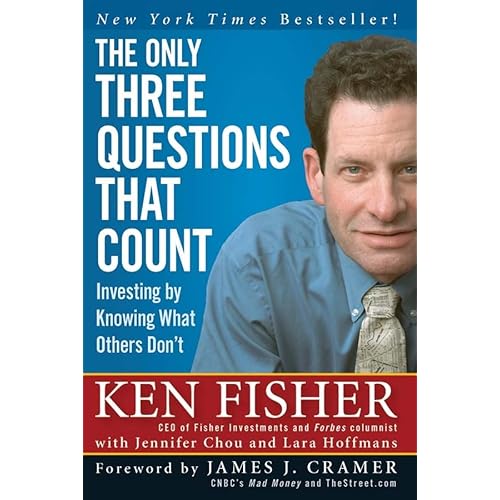
This is part 2 of 2, relating to a review of Mr. Fisher's book. The first segment is
here.I have some issues with Mr. Fisher's book and some of his "revolutionary" thinking. Given the tone of his book, I'm certain he would be absolutely dismissive of what I have to say but, nevertheless, I'm going to charge in anyway.
Mr. Fisher's big opening statement in his book challenges a long-held market axiom that high PE's denote reduced returns for some period of time into the future. He states that the year immediately following a high PE year has virtually no statistical inverse correlation. While this might be true, it ignores the fact that there is heightened risk of a reduced return into the relatively near term future. Whether that lower return is realized in the immediate year following, Mr. Fisher's data suggests, no.
However, an investor (rather than a "speculator" or "trader") would be foolish to ignore the reduced odds of outperformance that this period provides. For some further information and a detailed study on this issue, please go over to this
Gannon On Investing series, which discusses this in greater detail. (Use the top navigation link to continue moving forward in this interesting series). Essentially, Mr. Gannon's work shows that poor returns (perhaps not the immediate year following) generally follow high PE years.
I find that his presentation and discussion of the data is of considerably more value to me than Mr. Fisher's more short-term consideration. In terms of data presentation, in Mr. Fisher's book, in an attempt to convince that there's virtually no correlation between PEs and market returns, he presents what he calls a "Bell Curve" showing relative PEs. Here is a truncated version of his "Bell Curve":

(see Figure 1.3 on page 18 of the book).
When I look at this, it doesn't remind me of a Bell Curve, which I always understood to look something like this ...

... so when I look at it, my mind still tries to fit a rough bell curve to it. What I can clearly see is that, on the periphery, there appears to be a clear correlation between average returns and PEs. For instance, the average return from the 11 occurrences in the far left hand (low PEs) column is 20.0%. If I aggregate all the small right hand columns (High PEs), this totals some 17 occurrences, and the average return there is just 6.5%.
Perhaps a better way to think about this, I arrive at, is that in the middle values, the PE isn't the most important determinant of future return. But on the edges, it's clearly very important. Geoff Gannon's work certainly supports this thesis too. But I know that Mr. Fisher would probably be completely dismissive of me, attributing my criticisms to my inability to ditch an old world view.
Later in the book, he puts to rest another worry, that high government deficits and debt result in poor market returns. Don't Worry!, his research shows, Be Happy! I'd say that the way he approaches this theme is similar to the first; he takes the short term view and therefore "proves" this doesn't impact the market.
I look at it like this: while the party is going on with borrowed money, all looks great. There's no evidence to suggest that the house will be trashed the next morning and in dire need of repair. Party on dudes!
However, over the longer term, a sensible brain would say that the money is going to have to be paid back, and given the the US already has one of the lower tax regimes in the developed world (suggesting that the opportunity for service cuts are somewhat limited), how will this money likely be paid back? Hummm, by raising taxes, perhaps even corporate taxes?? And when taxes are raised, what is that likely to do to corporate profits, or at least profit growth rates?
In summary, I find that Mr. Fisher often takes a relatively short term view in framing his questions, more akin, in my view, to a trader, than a long-term investor. Having said that however, and despite my criticisms here, I still think that the book is a worthwhile read.
Just be careful how you use the outcome of some of the questions that Mr. Fisher frames.
Feb 13/07: I have added this post-script because I think I have probably been somewhat harsh in my criticism of this book. What makes it worthwhile, in my opinion, is that it's one of the very few books out there that shows how a "top-down" approach might succeed.Most books - mine included - tend to focus on "bottom-up" approaches that focus on relative and absolute valuations. Some wander off into the "asset-allocator" field as a sideline, but few provide any indication of how a top-down approach might be successfully employed and some tools to do that with. Mr. Fisher's book does that. However, I'd still be cautious as to using the exact answers that Mr. Fisher comes up via his own questions, as I believe there's an inherent amount of risk in ignoring certain longer-term probabilities [something I think that many of Mr. Fisher's questions do] - i.e. poorer longer term returns when investing when PEs are high; and government deficit and debt situations that may act as trigger events for market debacles. 
JW
The Confused Capitalist
 Just like an unruly child, the Confused Capitalist has passed his first birthday on this earthly plane (... this blog was started February 18 2006), with a happy smile on his face.
Just like an unruly child, the Confused Capitalist has passed his first birthday on this earthly plane (... this blog was started February 18 2006), with a happy smile on his face.




